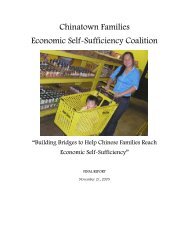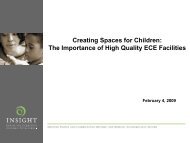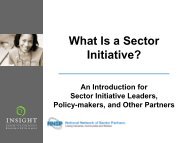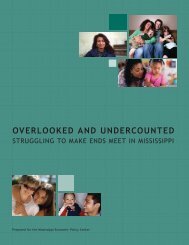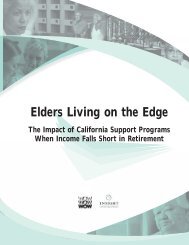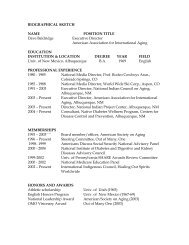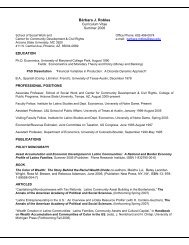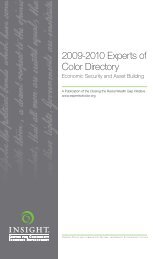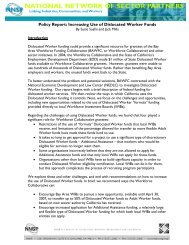Envisioning a Better Future for Working Families in Mississippi
Envisioning a Better Future for Working Families in Mississippi
Envisioning a Better Future for Working Families in Mississippi
You also want an ePaper? Increase the reach of your titles
YUMPU automatically turns print PDFs into web optimized ePapers that Google loves.
2) Build<strong>in</strong>g a Coalition and Political Will, and<br />
3) Address<strong>in</strong>g Cost Concerns.<br />
It should be stated from the outset, however, to fully implement these recommendations,<br />
more <strong>in</strong>vestment is needed <strong>in</strong> local organizations to strengthen their capacity to move<br />
<strong>for</strong>ward with this labor-<strong>in</strong>tensive work.<br />
Education and Tra<strong>in</strong><strong>in</strong>g<br />
As mentioned, the number one barrier cited <strong>for</strong> us<strong>in</strong>g the Self-Sufficiency Standard <strong>in</strong> <strong>Mississippi</strong> was lack of<br />
awareness. There<strong>for</strong>e, more on-the-ground education and tra<strong>in</strong><strong>in</strong>g—<strong>in</strong>dividually, at conferences, and <strong>in</strong><br />
small groups—are needed <strong>for</strong> organizations to understand the Standard and <strong>in</strong>tegrate it <strong>in</strong>to their<br />
programs and policy advocacy strategies.<br />
Specifically, the follow<strong>in</strong>g education and tra<strong>in</strong><strong>in</strong>g steps would help move the Standard <strong>for</strong>ward <strong>in</strong> <strong>Mississippi</strong>:<br />
1. Identify a lead tra<strong>in</strong><strong>in</strong>g organization (e.g. ECD).<br />
2. Educate stakeholders and the general public on why an alternative measure is needed (e.g. flaws of<br />
the Federal Poverty Guidel<strong>in</strong>es), how the Standard is a more realistic and mean<strong>in</strong>gful <strong>in</strong>dex, and the<br />
benefits and opportunities that can flow from adopt<strong>in</strong>g the Standard.<br />
3. Beg<strong>in</strong> to create local ownership amongst coalition members and the wider circle of stakeholders by<br />
gett<strong>in</strong>g respected local leaders to start us<strong>in</strong>g the Standard and speak<strong>in</strong>g out about its benefits<br />
publicly through tra<strong>in</strong><strong>in</strong>gs, conferences, web<strong>in</strong>ars and <strong>in</strong>dividual meet<strong>in</strong>gs.<br />
4. Provide models of how the Standard has been used by other conservative states, ideally also <strong>in</strong> the<br />
South.<br />
Build<strong>in</strong>g A Coalition and Political Will<br />
Among policy leaders and advocates, political resistance was the most commonly cited challenge to<br />
statewide adoption of the Standard. Related, several leaders expressed that organizations did not<br />
collaborate to build coalitions across related sectors.<br />
Next steps to build a coalition and greater political acceptance over time <strong>in</strong>clude:<br />
1. Identify an organization to take the lead on build<strong>in</strong>g a coalition (e.g. CDF).<br />
2. Set short-term, medium-term, and long-term goals around adopt<strong>in</strong>g the Standard among local<br />
organizations, foundations, and, over time, public agencies.<br />
3. Organize holistically—us<strong>in</strong>g both a grass-roots approach and official <strong>in</strong>volvement—to build and<br />
susta<strong>in</strong> a consistent campaign across sectors. This <strong>in</strong>cludes:<br />
a. Educat<strong>in</strong>g and build<strong>in</strong>g relationships with public adm<strong>in</strong>istrators and officials on how the Self-<br />
Sufficiency Standard can fit <strong>in</strong>to exist<strong>in</strong>g state programs, rather than need<strong>in</strong>g to “re<strong>in</strong>vent the<br />
wheel” and<br />
b. Partner<strong>in</strong>g with well-respected and recognized advocacy champions who can effectively<br />
deliver the message to legislators.<br />
4. Use common language when speak<strong>in</strong>g about the Self-Sufficiency Standard, so that legislators do<br />
not get confused by different measurements cited.<br />
<strong>Envision<strong>in</strong>g</strong> a <strong>Better</strong> <strong>Future</strong> <strong>for</strong> <strong>Work<strong>in</strong>g</strong> <strong>Families</strong>—February, 2010 Page 10



